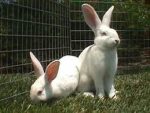Dear fellow animal lovers! Have you ever tasting rabbits meat? While some of you may ask, “What? Eating those cute and lovely rabbits?” But, yeah, some others love those cute and lovely rabbits for a whole different reason; the delicacy of their meat. That being said, you can farm rabbits for being pet, their fur, as well as their meat, like any other livestock.
Rabbits mature quickly and do not require too much attention or space. FYI, rabbits have been raised for their meat for a long time (since the 1500s!), and for good reason. It is cheap to feed rabbits as they do not eat anything expensive, the meat is highly digestible, has very little fat, and contain 21% of protein content.
Rabbit meat tastes like chicken; it has a very clean, mild taste. It is also highly prized by chefs, and excellent used in any recipes as a replacement for chicken or pork making it the favorite meat of the French cuisine.
So, have you taken interest in keeping rabbit for meat now? Well, you’ve come to the right place, because here we have 5 effective guidance to breeding for meat.
- Preparing the hutch and the cage
The very first thing you need to consider before starting is housing because there will be more than just a couple of bunnies and they will spend most of their time there. Using metal cages or hutches will protect them from predators and improves sanitation.
While you can make your own cages by wire, the commercial cages that are well designed and readily available is an excellent investment. Another option is getting some secondhand things by watching your local resale sources such or from senior breeders. Note that the wire hutches can cause sore feet, you may want to provide a plank or a piece of carpet so your rabbits can rest.
Things you have to pay attention to when setting the hutch and the cage is that rabbits can withstand cold better than heat. Thus, shade and good ventilation are important. Easy access to clean water and food are also crucial.
- Choosing the right breed
You want to have a breed that has large litters and grows quite quickly, possibly to a large size. Referring to those criteria, New Zealand and Californians are the most common breeds for meat rabbits. Both have a nice litter size, the does are usually good moms, as well as produce a fast-growing and well-constructed carcass. Starting with a good quality pair or trio of a standard breed is recommended until you get comfortable and familiar with the process.
However, it has been found that crossing different breeds gives better meat rabbits. Certain breeds have proven to have very good maternal characteristics while others have very good paternal characteristics, and crossing rabbits that meet these criteria will lead to a very efficient result. Make sure to check the weight gain records of their parents, or the offspring themselves before purchasing your first rabbits. We also suggest that you find an experienced breeder, as usual, to help you make sure that you pick a healthy stock with no defects. Having experienced eyes and someone to mentor you are always worth their weight in gold.
- Giving the right food
A commercial pellet is a good start due to its availability, consistency in quality, and already researched to meet the needs of meat rabbits. Adding treats to your rabbits’ diets are recommended. For example, timothy hay as a treat helps stimulate bunny tummies. Other treats they love are carrots, apples, and whole sunflower seeds. Note that those treats are supplements, and too much of them can cause digestive problems.
Some breeders said natural feed like grass can fatten rabbits faster. It is also cheaper than pellets. Try both to see which one that will work better to your rabbits. Remember that anything you include to your meat rabbits diets are given on a trial basis first. Give them sticks such as maple branches to provide something safe for rabbits to work their teeth on because those teeth keep growing throughout their life.
- Breeding meat rabbits
As we all know, rabbits produce rapidly. They have a 30-day gestation cycle and become mature at seven months. Plus, you can breed the same doe once every 90 days.
Seven weeks old rabbits are considered grown enough to butcher. At this point, they are weaned and should be placed in their own hutch, then butchered after a couple more weeks.
You want to keep three months old female rabbits separately from the males. They will still be economical until about eight months but you may need to butcher and freeze them or let other breeders adopt them. Generally, you can butcher your breeding rabbits once they reach three years old.
To breed your rabbits, move the doe into the buck’s cage, never the opposite. Watch to ensure they breed at least once, better twice, then return the doe to her own cage.
- Know your meat product
Rabbits processed for meat are called fryers, roasters or stewers which determined by the age and weight of the rabbits.
Fryers are the common type of domestic meat rabbit. Fryers are less than 10 weeks old and 3.5 to 5.5 pounds live. Fryers’ meat are tender with a fine texture and a bright pearly white color.
Roasters are 10 weeks to 6 months old and 5.5 to 9 pounds live. Both fryers and roasters’ carcass should be more than half its live weight including the liver, heart, and kidneys. Roasters’ flesh is firmer than fryers’ and slightly darker with a coarser texture.
Stewers are rabbits over 6 months old and must have a weight of 8 pounds or more live. Their carcass is usually firmer and contains more fat.
All of them can be sold alive or as whole carcasses. Sometimes, they are sold in pieces as a cut-up carcass including certain organs that can be eaten.

